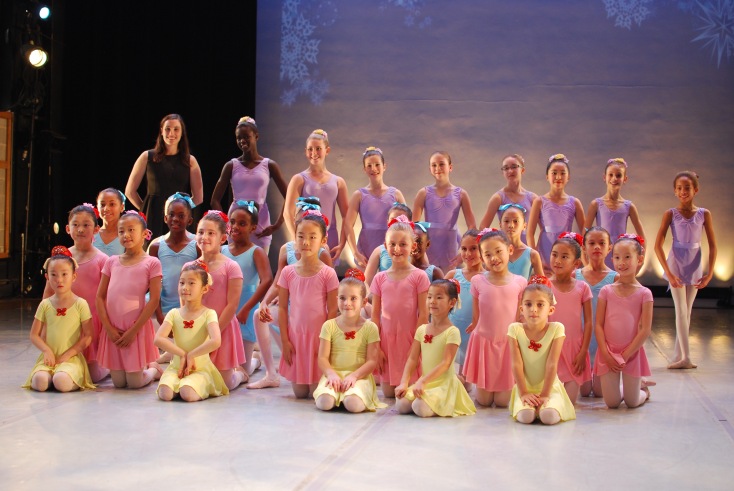After a week-long vacation, our Weekly Faculty Interviews are back! With American Ballet Theatre Day coming up in a week, we’ll be interviewing Maeve Dougal, the Director of our American Ballet Theatre ® (ABT) program and the Assistant Director of the Rutgers Summer Dance Conservatories! Did we mention that she was also the Mason Gross Extension Division’s Faculty Member of the Month for February?
 Maeve Dougal holds an MA in Dance Education/ABT Ballet Pedagogy from New York University and a BFA in Dance with a Ballet Emphasis from Utah Valley University. She received her early ballet training at The School of Oregon Ballet Theatre under Damara Bennett and danced with Utah Regional Ballet under Jacqueline P. Colledge and Heather Gray. Dougal is an ABT Affiliate Teacher who has successfully completed the ABT Teacher Training Intensive in Primary through Level 7 and Partnering of the ABT National Training Curriculum.
Maeve Dougal holds an MA in Dance Education/ABT Ballet Pedagogy from New York University and a BFA in Dance with a Ballet Emphasis from Utah Valley University. She received her early ballet training at The School of Oregon Ballet Theatre under Damara Bennett and danced with Utah Regional Ballet under Jacqueline P. Colledge and Heather Gray. Dougal is an ABT Affiliate Teacher who has successfully completed the ABT Teacher Training Intensive in Primary through Level 7 and Partnering of the ABT National Training Curriculum.
In addition to teaching, Dougal was an executive assistant for Youth America Grand Prix (YAGP). She has completed administrative internships with The George Balanchine Trust and the New York Choreographic Institute at New York City Ballet, and with American Ballet Theatre’s second company, ABT II.
TJ: What initially inspired you to go into the arts?
MD: My family enrolled me in arts education programs at a very early age. I took classes in visual arts, music, theater, and ballet for as long as I can remember! When I was in 6th grade, I attended the Vancouver School of Arts and Academics, which is a progressive school for young artists in grades 6 – 12 in Washington State. I became really inspired and passionate about my dance studies while at this school, and the rest is history!
TJ: Was there a teacher who made an impact upon your development as an artist? How did they impact your own work as a teacher?
MD: It would be hard to pick just one! They all impacted me in one way or another. One of my earlier teachers, Jan Hurst, inspired me through performance opportunities and by fostering such a creative and nurturing social environment for learning. Damara Bennett taught me how important it was to work your absolute hardest in every class and the corresponding satisfaction that comes from the results of hard work. That’s something that is really important to me today as a teacher. Your body and natural talent are just tools; it is how you work with the talent you have been given that determine your successes.
In college, Jacqueline P. Colledge and Heather Gray (a mother/daughter team) were literally a dream come true to work with. They are just brilliant teachers and their students have such beautiful and pure, classical technique. I learned more from them in four years than I had learned in my entire time as a young dance student. I still hear their voices and feel their influence when I teach!
Raymond Lukens and Franco DeVita gave me a platform to use all of the knowledge I had gathered through my years of training and taught me how to make sense of it all and how to break down that knowledge in order to build curricula for young dancers. They are two of the most knowledgeable people on the subject of classical ballet, and I learned so much from them. I’m very grateful to have started my teaching career under their tutelage.
TJ: What is the most rewarding part of teaching for you?
MD: I love when my students have “a-ha!” moments. Who doesn’t? Those are the most exciting for me, when a student finally understands a concept that will transform their class work. I also feel so much pride any time I see them onstage or performing in their ABT exam classes. It’s easy when you are in the process with them day-to-day to forget where they started, but then you see them in their end of the year exam and you realize how far they’ve come and how hard they have worked. Seeing them onstage just fills me with joy because they just love it out there! They are all smiles, and that’s really what we work so hard for anyway.
TJ: How is ballet different from other styles of dance? What should prospective students know about ballet before deciding to try it out?
MD: Ballet is a very historical art form, and a lot of the rules and guidelines of classical ballet were established hundreds of years ago. It is very ritualistic. You begin classes with pliés and tendus every day, and you will for the rest of your life! So you have to be okay with revisiting the same exercises and steps day after day. I believe it is like most art forms, though, that you must learn the rules before you break them. So I think it’s very important for dancers of all genres to have a strong foundation in classical ballet. You don’t have to be a master of classical ballet to be good at other genres, but you do need those fundamentals to build from. Prospective students need only a desire to learn (and a schedule that allows them to commit to the classes), and I will happily teach them!
TJ: Do you have a favorite ballet? Which one and why?
MD: I can’t narrow this down have to pick THREE! I love Giselle because it’s such a classical story ballet. I love the music, the corps de ballet work, the costumes, the characters, literally all of it. It’s just a gorgeous ballet.
I also love George Balanchine’s Serenade and will never forget the first time I saw it. It is my favorite piece by Tchaikovsky (and I’m a huge Tchaikovsky fan!) and the opening chord struck me so deeply that my eyes welled up with tears as a 14 year old girl! It’s one of those pieces where the movement really brings the music to life and you think, this must have been what Tchaikovsky was envisioning when he wrote this music.
Lastly, Romeo & Juliet. Again, the music is incredible, but any great, tragic love story always grabs my heart. I attended Julie Kent’s farewell performance as Juliet last spring and that was really special for me too because she was so iconic in that role.
TJ: What makes ABT the unique program it is today?
MD: I think that in the world we live in today, there is so much emphasis on tricks and turns and the instant gratification culture. Ballet teaches patience because there really are no short cuts other than showing up and working hard. You can go to another studio, and they may put you in pointe shoes too early or give you a big role that you haven’t quite earned yet, but if you go into the larger ballet world from that school you’ll see that they didn’t really do you any favors. We teach classical ballet technique—you can trace it back to its roots in the original dancing schools in France, Russia, Italy, Denmark—and we give you a vocabulary that means something in every great dancing school in the world.
I see a lot of students who come to me from other dancing schools and they can get their legs up to their ears or do 3 pirouettes, but they have weird habits and poor placement. I think placement and alignment are really important things to teach, not only because it’s correct, but also because it protects the body from injury. There’s a science to it really. Every body can learn to dance correctly, and dancing correctly is what keeps a dancer safe and free from injury. We also have live music in all of our classes, which is really a treat and something I’m thrilled that Mason Gross values because it emphasizes musicality and helps the dancers be more present.
Thanks so much for you time, Maeve!
For more information about the Mason Gross Extension Division’s American Ballet Theatre program, please visit the American Ballet Theatre web page here! The American Ballet Theatre (ABT) Children’s Division follows a specific graded curriculum divided by age, which is outlined in ABT’s national training curriculum. Each level is designed to be sensitive to the developmental needs of the age group. Class size is limited. The curriculum combines scientific principles with elements from the classic French, Italian, and Russian schools of training. Students must attend all classes listed for their level. Primary classes are open enrollment and no prior experience is necessary.
You may also find more information about ABT Day here! ABT Day at Mason Gross is an annual event consisting of an afternoon of workshops and master classes featuring faculty members and dancers from American Ballet Theatre. The events celebrates young dancers (ages 4-18) providing them with the opportunity to experience state of the art, age appropriate instruction utilizing ABT’s National Training Curriculum. Parents and instructors have the opportunity to learn first hand about ABT’s unique curriculum through class observation. A performance featuring ABT’s world class Studio Company closes the event!
